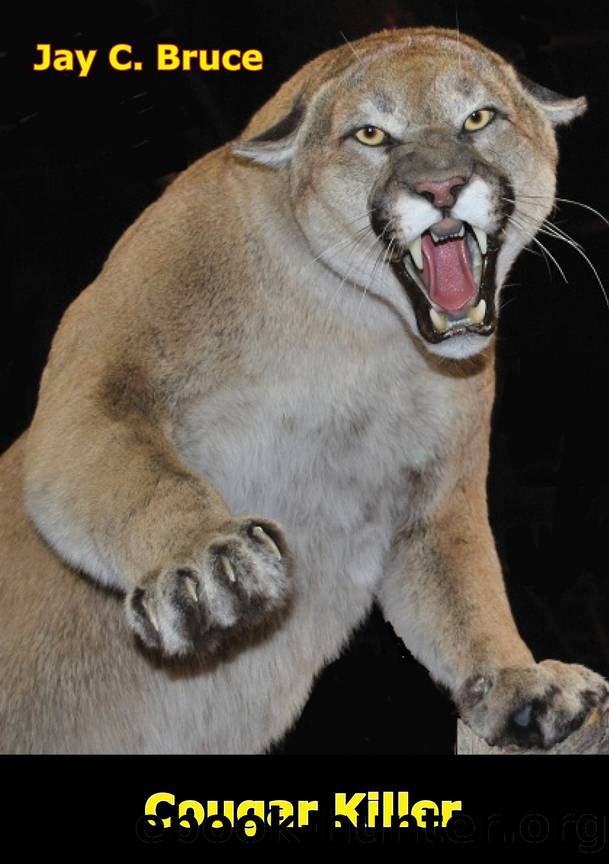Cougar Killer by Jay C. Bruce

Author:Jay C. Bruce
Language: eng
Format: epub
Publisher: Pickle Partners Publishing
Published: 2016-08-31T00:00:00+00:00
IIIâLIONS KEEP THE WOLF FROM OUR DOOR
Eli and I on Our First Lion Hunt
THE WINTER OF 1915 brought our third child, the end of my job with Baxter and the return of the perennial problem of earning a living. The five of us arrived home in mid-afternoon of December 1 with the proverbial wolf on our trail and due to overtake us soon unless Eli and I could cash in on a couple of lions without delay. However, we were not worried by one problem confronting the present-day family when short of cashâthe high cost of meatâfor there was an ample supply of deer in the woods and I had a good carbine, two sharp eyes and one uninjured hand to use in bringing home the venison. Our main worry was how to get groceries; thatâs where the lion bounties would count. But I couldnât track lions on ground frozen so hard no prints could be made by the catâs soft paw-pads. I would have to wait for a snowfall. Luckily, storm clouds began gathering the next day, December 2. By nine oâclock that evening the cold, but welcome, white flakes were drifting down in abundance, giving promise of a layer deep enough to make tracking easy by daybreak.
At 6:00 A.M. the next morning I arose to examine conditions, and found the trees robed in white, while a carpet of snow six inches thick covered the ground. I knew it would be several inches deeper near the base of Wawona Dome, three miles from our dwelling and a thousand feet higher. It was not by accident that I chose this particular section for this important lion hunt. First, the course followed by deer on their migration down country in the early winter and up country during the spring followed the 5000-foot contour line extending through this area and nearly parallel to the South Fork of the Merced River, which flowed westerly through the valley to the south. Situated on a sun-exposed southerly slope, this area produced three varieties of ceanothus (branches of the Buckthorn family), namely: Ceanothus integerrimus (deer brush), Ceanothus velutimus (mountain Mahogany), and Ceanothus cuneatus, all of which provide nourishing food for deer during the winter months. Thus, deer could be found here throughout an average year, the exception being winters of unusually deep snows. In addition to an abundance of venison for food, the area provided ideal shelter for all species of predatory animals, as well as winter dens for bears of all sizes. At the upper edge, these shelters consisted of cave-like holes among the granite boulders and slabs which nature had cast from the lofty face of Wawona Dome and piled at random along its base. A half mile below stood a series of granite walls some two to three hundred feet high and a half mile in length. Here, too, Mother Nature had constructed numerous storm shelters for her wilderness creatures, both large and small. The terrain was ideal for both deer and their natural enemies, particularly the cougar.
Download
This site does not store any files on its server. We only index and link to content provided by other sites. Please contact the content providers to delete copyright contents if any and email us, we'll remove relevant links or contents immediately.
Backpacker the Complete Guide to Backpacking by Backpacker Magazine(2193)
Capital in the Twenty-First Century by Thomas Piketty(1944)
The Isle of Mull by Terry Marsh(1891)
Predation ID Manual by Kurt Alt(1653)
The Collected Non-Fiction by George Orwell(1570)
Small-Bore Rifles by C. Rodney James(1502)
All Fishermen Are Liars by John Gierach(1443)
Backcountry Bear Basics by Dave Smith(1433)
Creative Confidence by Tom Kelley(1413)
The Art of Throwing by Amante P. Marinas Sr(1353)
50 Famous Firearms You've Got to Own by Rick Hacker(1338)
Archery: The Art of Repetition by Simon Needham(1301)
Blood Mountain by J.T. Warren(1301)
Long Distance Walking in Britain by Damian Hall(1278)
The Scouting Guide to Survival by The Boy Scouts of America(1247)
Backpacker Long Trails by Backpacker Magazine(1245)
The Fair Chase by Philip Dray(1224)
The Real Wolf by Ted B. Lyon & Will N. Graves(1209)
The Ultimate Guide to Home Butchering by Monte Burch(1200)
